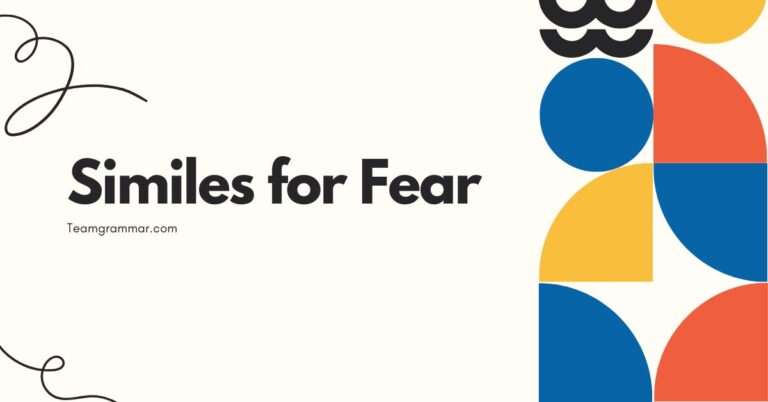43 Similes for Support: Enhancing Your Writing with Vivid Comparisons
Similes are powerful tools in the English language, allowing writers and speakers to create vivid images and enhance understanding by drawing comparisons between dissimilar things. Mastering the use of similes can significantly improve your writing and communication skills, making your language more engaging and memorable.
This article provides a comprehensive guide to similes, covering their definition, structure, types, usage rules, common mistakes, and offering practical exercises to help you become proficient in their use. Whether you are a student, a writer, or simply someone looking to improve their English, this guide will equip you with the knowledge and skills to effectively incorporate similes into your language.
Table of Contents
- Definition of Similes
- Structural Breakdown of Similes
- Types and Categories of Similes
- Examples of Similes
- Usage Rules for Similes
- Common Mistakes with Similes
- Practice Exercises
- Advanced Topics in Similes
- Frequently Asked Questions (FAQ)
- Conclusion
Definition of Similes
A simile is a figure of speech that directly compares two different things using the words “like” or “as.” The purpose of a simile is to create a more vivid and descriptive image in the reader’s mind by highlighting the similarities between the two things being compared. Similes are a type of figurative language, which means they use words or expressions with a meaning that is different from the literal interpretation.
Similes are used to make descriptions more interesting and relatable. They can add depth and color to writing, allowing readers to visualize and understand concepts more easily.
By drawing a comparison to something familiar, a simile can help to clarify complex or abstract ideas.
In essence, a simile functions as a bridge between the known and the unknown, making the unfamiliar more accessible and understandable. It enhances communication by painting a picture with words, making the message more engaging and memorable.
Structural Breakdown of Similes
The basic structure of a simile typically involves three key components: the subject (the thing being described), the comparison word (“like” or “as”), and the object of comparison (the thing to which the subject is being compared). Understanding this structure is crucial for creating effective and clear similes.
The structure can be represented as: Subject + Comparison Word (like/as) + Object of Comparison.
For instance, in the simile “She is as brave as a lion,” “she” is the subject, “as” is the comparison word, and “a lion” is the object of comparison. This structure helps to clearly establish the relationship between the two things being compared.
The clarity and effectiveness of a simile depend on the strength and relevance of the comparison. A good simile should create a vivid and understandable connection between the subject and the object of comparison.
The comparison should highlight specific qualities or characteristics that the two share, making the description more impactful and memorable.
Let’s break down another example. Consider the simile: “The snow was like a blanket.” Here, “the snow” is the subject, “like” is the comparison word, and “a blanket” is the object of comparison.
The simile suggests that the snow is covering something completely and providing warmth or protection, just like a blanket would.
Here is another example: “He ran as fast as the wind.” In this case, “He” is the subject, “as” is the comparison word, and “the wind” is the object of comparison. This simile emphasizes the speed at which he ran, comparing it to the swiftness of the wind.
Understanding the structural components of a simile allows for the creation of more precise and effective comparisons, enhancing the descriptive power of your writing.
Types and Categories of Similes
Similes can be categorized based on the type of comparison they make or the effect they create. While there aren’t strict, universally agreed-upon categories, we can generally classify them based on their descriptive focus.
Here are a few common types:
Descriptive Similes
These similes focus on describing the physical attributes or qualities of the subject. They often use sensory details to create a vivid image in the reader’s mind.
For example, “Her eyes were like the deep blue sea” describes the color and depth of her eyes.
Behavioral Similes
These similes compare the actions or behavior of the subject to something else. They can be used to highlight certain traits or characteristics.
For example, “He eats like a pig” describes someone who eats messily and greedily.
Emotional Similes
These similes relate to feelings or emotions, helping to convey the intensity or nature of those emotions. For example, “She felt as light as a feather” describes a feeling of happiness or relief.
Abstract Similes
These similes compare abstract concepts or ideas to something more concrete or relatable. For example, “Life is like a box of chocolates” compares the unpredictable nature of life to the variety of chocolates in a box.
Exaggerated Similes
These similes use hyperbole to emphasize a particular quality or characteristic. For example, “He is as tall as a skyscraper” exaggerates the person’s height.
Examples of Similes
To further illustrate the use of similes, here are several examples categorized by the aspect they describe. Each example aims to provide a clear and vivid comparison, enhancing the reader’s understanding.
Similes Describing Appearance
These similes focus on physical attributes and visual qualities, providing a clear image of the subject being described. The following table presents a variety of examples that highlight different aspects of appearance.
| Simile | Explanation |
|---|---|
| Her skin was as smooth as silk. | Describes the texture of her skin. |
| His hair was like spun gold. | Describes the color and texture of his hair. |
| The building stood as tall as a mountain. | Emphasizes the height of the building. |
| The lake was as clear as glass. | Describes the clarity of the water. |
| Her eyes were like sparkling diamonds. | Highlights the brightness and beauty of her eyes. |
| The clouds were as white as cotton. | Describes the color and softness of the clouds. |
| His beard was like a tangled forest. | Describes the thickness and untidiness of his beard. |
| The moon was as bright as a spotlight. | Emphasizes the brightness of the moon. |
| Her dress was as red as a rose. | Describes the color of her dress. |
| The statue was as still as stone. | Highlights the immobility of the statue. |
| His face was like a roadmap of wrinkles. | Describes the many wrinkles on his face. |
| The snow was as pure as a dove. | Describes the purity and whiteness of the snow. |
| Her smile was as radiant as the sun. | Emphasizes the brightness and warmth of her smile. |
| The old book was like a treasure chest. | Describes the value and richness of the book. |
| His teeth were as white as pearls. | Describes the color and shine of his teeth. |
| The city at night was like a sea of lights. | Describes the vastness and brightness of the city lights. |
| Her voice was as clear as a bell. | Describes the clarity and pleasantness of her voice. |
| The jewelry shop was as shiny as a showroom. | Describes the cleanliness and shine of the jewelry shop. |
| The castle was as majestic as a king. | Describes the granduer of the castle. |
| The sunrise was as colorful as a rainbow. | Describes the variety of colors in the sunrise. |
| The flower was as delicate as a butterfly. | Describes the fragility of the flower. |
| The sculpture was as shiny as a mirror. | Describes the shine of the sculpture. |
| The art piece was as vibrant as a carnival. | Describes the livliness of the art piece. |
| The car was as sleek as an arrow. | Describes the smoothness of the car. |
| The diamond ring was as sparkly as a star. | Describes the shine of the ring. |
Similes Describing Behavior
These similes focus on actions, habits, and ways of behaving, helping to illustrate character traits and tendencies. The table below presents various examples to showcase different behavioral aspects.
| Simile | Explanation |
|---|---|
| He eats like a horse. | Describes someone who eats a lot. |
| She sings like an angel. | Describes someone with a beautiful voice. |
| They fought like cats and dogs. | Describes a relationship full of conflict. |
| He works like a machine. | Describes someone who works tirelessly and efficiently. |
| She runs like the wind. | Describes someone who runs very fast. |
| He slept like a log. | Describes someone who sleeps very soundly. |
| She cried like a baby. | Describes someone who cries uncontrollably. |
| He roared like a lion. | Describes someone who shouts loudly and aggressively. |
| She danced like a butterfly. | Describes someone who dances gracefully and lightly. |
| He swam like a fish. | Describes someone who swims very well. |
| She gossips like a magpie. | Describes someone who talks a lot about other people’s affairs. |
| He follows like a shadow. | Describes someone who closely follows another person. |
| She worries like a mother hen. | Describes someone who is overly concerned and protective. |
| He plans like a general. | Describes someone who is strategic and organized. |
| She argues like a lawyer. | Describes someone who is skilled at debating and making arguments. |
| He watches like a hawk. | Describes someone who is very observant and attentive. |
| She learns like a sponge. | Describes someone who absorbs information quickly and easily. |
| He perseveres like a bulldog. | Describes someone who is determined and persistent. |
| She leads like a queen. | Describes someone who is authoritative and commanding. |
| He jokes like a comedian. | Describes someone who is funny and makes people laugh. |
| She nags like a mother. | Describes someone who is constantly scolding. |
| He snores like a bear. | Describes someone who snores loudly. |
| She begs like a dog. | Describes someone who is desperate and pleading. |
| He hides like a turtle. | Describes someone who is shy and reclusive. |
| She plots like a fox. | Describes someone who is sly and cunning. |
Similes Describing Feelings
These similes are used to express emotions and internal states, helping to convey the intensity and nature of feelings. The following table provides examples that illustrate different emotional states.
| Simile | Explanation |
|---|---|
| He felt as light as a feather. | Describes a feeling of happiness or relief. |
| She felt as heavy as lead. | Describes a feeling of sadness or burden. |
| He was as nervous as a cat on a hot tin roof. | Describes a feeling of extreme nervousness. |
| She was as happy as a clam. | Describes a feeling of great happiness and contentment. |
| He was as angry as a hornet. | Describes a feeling of intense anger. |
| She felt as cold as ice. | Describes a feeling of emotional detachment or rejection. |
| He felt as empty as a hollow shell. | Describes a feeling of emptiness or loneliness. |
| She was as scared as a mouse. | Describes a feeling of intense fear. |
| He felt as free as a bird. | Describes a feeling of liberation and independence. |
| She was as excited as a child on Christmas morning. | Describes a feeling of extreme excitement and anticipation. |
| He felt as lost as a ship without a sail. | Describes a feeling of confusion and disorientation. |
| She was as calm as a still lake. | Describes a feeling of peace and tranquility. |
| He felt as trapped as a bird in a cage. | Describes a feeling of confinement and restriction. |
| She was as hopeful as a sunrise. | Describes a feeling of optimism and anticipation. |
| He felt as vulnerable as a newborn. | Describes a feeling of weakness and defenselessness. |
| She was as content as a cat purring. | Describes a feeling of satisfaction and comfort. |
| He felt as isolated as a lone island. | Describes a feeling of loneliness and separation. |
| She was as overwhelmed as a flood victim. | Describes a feeling of being overloaded and stressed. |
| He felt as refreshed as a rain shower. | Describes a feeling of invigoration and renewal. |
| She was as nostalgic as a vintage photograph. | Describes a feeling of longing for the past. |
| He felt as heartbroken as a broken vase. | Describes a feeling of deep sadness. |
| She was as suspicious as a detective. | Describes a feeling of distrust. |
| He felt as awkward as a teenager. | Describes a feeling of discomfort. |
| She was as jealous as a rival. | Describes a feeling of envy. |
| He felt as grateful as a survivor. | Describes a feeling of thankfulness. |
Similes Describing Taste
These similes focus on the flavors and sensations experienced when tasting something. They can help to vividly describe the taste of food and drinks.
The following table provides examples that illustrate different tastes.
| Simile | Explanation |
|---|---|
| The soup tasted as bland as cardboard. | Describes a flavorless taste. |
| The lemonade was as tart as a lemon. | Describes a sour taste. |
| The chocolate was as sweet as honey. | Describes a very sweet taste. |
| The coffee was as bitter as medicine. | Describes a strong, unpleasant taste. |
| The spice was as hot as fire. | Describes a very spicy taste. |
| The candy was as sugary as syrup. | Describes a taste overloaded with sugar. |
| The fruit was as juicy as a watermelon. | Describes a taste that is moist and full of flavor. |
| The pie was as fruity as a summer garden. | Describes the pies fruitiness. |
| The meat was as gamey as a raccoon. | Describes a unique gamey taste. |
| The spice was as earthy as a forest. | Describes a strong earthy taste. |
Similes Describing Sound
These similes focus on the auditory qualities of things, helping to vividly describe sounds and noises. The following table provides examples that illustrate different sounds.
| Simile | Explanation |
|---|---|
| The music was as loud as a rock concert. | Describes a very loud sound. |
| Her voice was as soft as a whisper. | Describes a very quiet sound. |
| The thunder was as booming as a cannon. | Describes a deep, resonant sound. |
| The rain was as gentle as a lullaby. | Describes a soothing, soft sound. |
| The wind was as howling as a wolf. | Describes a strong, mournful sound. |
| The siren was as shrill as a scream. | Describes a high-pitched, piercing sound. |
| The clock was as ticking as a time bomb. | Describes a suspenseful ticking sound. |
| The birds were chirping as happily as a choir. | Describes a happy sound. |
| The engine was as roaring as a racecar. | Describes a strong sound. |
| The bell was as ringing as a church. | Describes a clear, loud sound. |
Usage Rules for Similes
Using similes effectively involves understanding certain rules and guidelines to ensure clarity, relevance, and impact. Here are some key rules to keep in mind:
- Use “like” or “as”: Similes must use either “like” or “as” to make the comparison. This is what distinguishes them from metaphors, which imply a comparison without using these words.
- Compare dissimilar things: The two things being compared should be different enough to create a meaningful and interesting comparison. Comparing similar things doesn’t create a simile; it’s just stating a fact.
- Ensure clarity: The comparison should be clear and easy to understand. Avoid obscure or overly complex comparisons that might confuse the reader.
- Be relevant: The comparison should be relevant to the context and the point you are trying to make. The simile should enhance the description or explanation, not distract from it.
- Avoid clichés: While some similes are common, try to avoid overused or cliché similes that have lost their impact. Aim for fresh and original comparisons that will capture the reader’s attention.
- Maintain consistency: Ensure that the simile aligns with the tone and style of your writing. Avoid using similes that clash with the overall mood or theme of the piece.
- Use sparingly: While similes can enhance your writing, using too many can make it seem cluttered and overwhelming. Use them judiciously to create the greatest impact.
By following these rules, you can use similes effectively to enhance your writing, making it more vivid, engaging, and memorable. Remember that the goal of a simile is to create a clear and impactful comparison that adds depth and meaning to your words.
Common Mistakes with Similes
Even with a good understanding of similes, it’s easy to make mistakes in their usage. Here are some common errors to watch out for:
| Incorrect | Correct | Explanation |
|---|---|---|
| She is like happy. | She is as happy as a lark. | Similes must compare two nouns or noun phrases. “Happy” is an adjective. |
| He is as tall like a tree. | He is as tall as a tree. | Using both “as” and “like” is redundant. |
| The car is fast like a car. | The car is as fast as a bullet. | The comparison should be between dissimilar things. |
| The idea is as clear as mud. | The idea is as clear as crystal. | Ensure the comparison makes sense and conveys the intended meaning. |
| He runs quick like a cheetah. | He runs as quickly as a cheetah. | Use the correct form of the adjective or adverb. |
| She is like a good person. | She is like an angel. | Similes should be vivid and imaginative, not generic. |
Avoiding these common mistakes will help you use similes more effectively and enhance the quality of your writing.
Practice Exercises
Test your understanding of similes with these practice exercises. Fill in the blanks with appropriate words or phrases to complete the similes.
Answers are provided below.
| Question | Answer |
|---|---|
| 1. The baby’s skin was as soft as _____. | The baby’s skin was as soft as silk. |
| 2. The coffee was as bitter as _____. | The coffee was as bitter as medicine. |
| 3. He ran as fast as _____. | He ran as fast as the wind. |
| 4. She sings like _____. | She sings like an angel. |
| 5. The snow was as white as _____. | The snow was as white as a dove. |
| 6. The old house stood as silent as _____. | The old house stood as silent as a tomb. |
| 7. He was as nervous as _____. | He was as nervous as a cat on a hot tin roof. |
| 8. Her eyes were like _____. | Her eyes were like sparkling diamonds. |
| 9. The soup tasted as bland as _____. | The soup tasted as bland as cardboard. |
| 10. The music was as loud as _____. | The music was as loud as a rock concert. |
| Question | Answer |
|---|---|
| 11. The night sky was as dark as _____. | The night sky was as dark as ink. |
| 12. The sun was as hot as _____. | The sun was as hot as fire. |
| 13. The air was as crisp as _____. | The air was as crisp as an apple. |
| 14. The car was as sleek as _____. | The car was as sleek as an arrow. |
| 15. The joke was as corny as _____. | The joke was as corny as an old joke book. |
| 16. The puzzle was as difficult as _____. | The puzzle was as difficult as rocket science. |
| 17. The story was as captivating as _____. | The story was as captivating as a movie. |
| 18. The argument was as heated as _____. | The argument was as heated as a debate. |
| 19. The apology was as sincere as _____. | The apology was as sincere as a handshake. |
| 20. The challenge was as daunting as _____. | The challenge was as daunting as a mountain. |
Advanced Topics in Similes
For advanced learners, exploring more nuanced aspects of similes can further enhance their writing skills. Here are some advanced topics to consider:
- Subverting Expectations: Instead of using common or predictable comparisons, try to create similes that are unexpected or ironic. This can add a layer of complexity and intrigue to your writing.
- Combining Similes: Use multiple similes in a single sentence or paragraph to create a richer and more layered description. This can be particularly effective in descriptive writing.
- Similes in Different Genres: Explore how similes are used differently in various genres, such as poetry, fiction, and non-fiction. Pay attention to the tone, style, and purpose of the similes in each genre.
- Cultural Context: Be aware of the cultural context of your similes. Some comparisons may not be universally understood or may have different connotations in different cultures.
- Developing a Unique Voice: Experiment with creating your own unique similes that reflect your personal style and perspective. This can help you develop a distinctive voice as a writer.
Frequently Asked Questions (FAQ)
-
What is the difference between a simile and a metaphor?
A simile is a comparison using “like” or “as,” while a metaphor directly equates two things without using these words. For example, “She is like a rose” (simile) versus “She is a rose” (metaphor).
-
Can a simile be a cliché?
Yes, a simile can be a cliché if it is overused and predictable. It’s best to avoid clichés and aim for fresh, original comparisons.
-
How can I make my similes more effective?
To make your similes more effective, ensure they are clear, relevant, and original. Choose comparisons that create vivid images and enhance the meaning of your writing.
-
Is it okay to use similes in formal writing?
Yes, similes can be used in formal writing, but they should be used judiciously and with careful consideration of the tone and style of the piece.
-
What are some examples of commonly used similes?
Some common similes include “as busy as a bee,” “as strong as an ox,” and “as wise as an owl.”
-
How do similes enhance writing?
Similes enhance writing by creating vivid images, clarifying complex ideas, and making the text more engaging and memorable.
-
Can similes be used in everyday conversation?
Yes, similes are commonly used in everyday conversation to make descriptions more interesting and relatable.
-
What is the purpose of using similes?
The purpose of using similes is to make descriptions more vivid and engaging by comparing two dissimilar things using “like” or “as.”
-
How do I choose the right simile for my writing?
Choose a simile that is relevant to the context, enhances the meaning, and creates a clear and impactful comparison. Consider the tone and style of your writing when selecting a simile.
-
Are there any types of writing where similes should be avoided?
In highly technical or scientific writing, where precision and objectivity are paramount, similes might be less appropriate. However, even in those contexts, a well-placed simile can sometimes aid understanding.
-
Can a simile compare abstract concepts?
Yes, similes can compare abstract concepts to more concrete or relatable things. For example, “Time is like a river” compares the abstract concept of time to the concrete image of a flowing river.
-
Why is it important to avoid clichés when using similes?
Clichés are overused and have lost their impact, making your writing sound unoriginal and uninspired. Fresh and original similes capture the reader’s attention and create a more memorable impression.
Conclusion
Similes are a valuable tool for enhancing your writing and communication skills. By understanding their structure, types, and usage rules, you can effectively incorporate similes into your language to create vivid images, clarify complex ideas, and make your message more engaging.
Remember to avoid common mistakes and clichés, and to practice using similes in different contexts to develop your skills.
Mastering the art of using similes can significantly improve your ability to express yourself clearly and creatively. Pay attention to the comparisons you encounter in literature, conversation, and everyday life, and use them as inspiration for creating your own unique and impactful similes.
With practice and attention to detail, you can become proficient in using similes to enrich your writing and captivate your audience.







